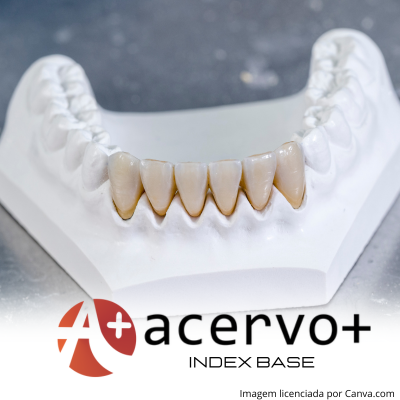Tratamento de superfície na resistência de união da cerâmica de zircônia
##plugins.themes.bootstrap3.article.main##
Resumo
Objetivo: Analisar os protocolos de tratamento de superfície para uma melhor resistência de adesão às cerâmicas a base de zircônia. Métodos: Trata-se de uma revisão integrativa da literatura, com artigos publicados entre 2013 e 2023, disponíveis em inglês e com textos completos. A pesquisa foi realizada na base de dados Pubmed, utilizando os descritores “zirconia", “surface treatment”, “bond strength", “resin cements” e “cementation”, combinados pelo operador booleano “AND”. Resultados: 17 artigos foram selecionados após aplicação dos critérios de inclusão e exclusão. Os tratamentos analisados foram classificados em tratamentos de superfície mecânicos (abrasão por jateamento de partículas, sistemas Rocatec, Siljet, Cojet e lasers) e químicos (condicionamento por infiltração seletiva, soluções de ácido fluorídrico e primers/silanos contendo MDP). A abrasão por jateamento aumentou a energia livre da superfície e melhorou a adesão, embora possa causar fragilização. Os sistemas como Rocatec, Siljet e Cojet promoveram boa retenção micromecânica com partículas de sílica. Os lasers não demonstraram melhora significativa, e o condicionamento por infiltração seletiva foi eficaz sem causar fraturas. As soluções de HF e primers/silanos mostraram desempenho insatisfatório. Considerações finais: Embora não haja um protocolo universal, técnicas específicas podem melhorar a resistência de união a longo prazo.
##plugins.themes.bootstrap3.article.details##
Copyright © | Todos os direitos reservados.
A revista detém os direitos autorais exclusivos de publicação deste artigo nos termos da lei 9610/98.
Reprodução parcial
É livre o uso de partes do texto, figuras e questionário do artigo, sendo obrigatória a citação dos autores e revista.
Reprodução total
É expressamente proibida, devendo ser autorizada pela revista.
Referências
2. ATOCHE-SOCOLA KJ, et al. Microshear bond strength of dual-cure resin cement in zirconia after different cleaning techniques: an in vitro study. The Journal of Advanced Prosthodontics, 2021; 13(4): 237.
3. BITENCOURT S, et al. Effect of laser irradiation on bond strength between zirconia and resin cement or veneer ceramic: A systematic review and meta-analysis. The Journal of Indian Prosthodontic Society. 2021;21(2):125.
4. DEEB JG, et al. Evaluation of Er:YAG and Er,Cr:YSGG laser irradiation for the debonding of prefabricated zirconia crowns. Advances in Clinical and Experimental Medicine, 2021 ;30(1):7–15.
5. FUSHIKI R, et al. Long-term Bond Strength between Layering Indirect Composite Material and Zirconia Coated with Silica based Ceramics. The Journal Of Adhesive Dentistry, 2015; 17(3):273–81.
6. GOYATA F, et al.. Effect of surface treatments with acid solutions on the surface roughness of an Yttrium-Tetragonal Zirconia Polycrystal. Journal of Clinical and Experimental Dentistry, 2018; 1.
7. GRASEL R, et al. Effect of Resin Luting Systems and Alumina Particle Air Abrasion on Bond Strength to Zirconia. Operative Dentistry. 2018; 1;43(3):282–90.
8. KUMAR R, et al. Effect of Surface Treatment of Zirconia on the Shear Bond Strength of Resin Cement: A Systematic Review and Meta-Analysis. Curēus, 2023; 15(9):e45045
9. PAPIA E, et al. Bonding between oxide ceramics and adhesive cement systems: A systematic review. Journal of Biomedical Materials Research Part B: Applied Biomaterials, 2013;102(2):395–413.
10. PERDIGÃO J, et al. Effect of Artificial Aging and Surface Treatment on Bond Strengths to Dental Zirconia. Operative Dentistry, 2013; 38(2): 168–76.
11. RUSSO DS, et al. Adhesion to Zirconia: A Systematic Review of Current Conditioning Methods and Bonding Materials. Dentistry Journal. 2019; 7(3): 74.
12. SAADE J, et al. Effect of different combinations of surface treatment on adhesion of resin composite to zirconia. Clinical, Cosmetic and Investigational Dentistry, 2019; 11:119–29.
13. SAADE J, et al. Evaluation Of The Effect Of Different Surface Treatments, Aging And Enzymatic Degradation On Zirconia-Resin Micro-Shear Bond Strength. Clinical, Cosmetic And Investigational Dentistry, 2020; 12:1-8.
14. SAMIMI P, et al. Effect of adhesive resin type for bonding to zirconia using two surface pretreatments. J Adhes Dent, 2015; 17(4): 353-359
15. TANIŞ MÇ, et al. Effect of selective infiltration etching on the bond strength between zirconia and resin luting agents. Journal Of Esthetic And Restorative Dentistry, 2018; 31(3):257–262.
16. TZANAKAKIS EGC, et al. Is there a potential for durable adhesion to zirconia restorations? A systematic review. The Journal of Prosthetic Dentistry, 2016; 115(1):9–19.
17. VALVERDE GB, et al. Surface characterisation and bonding of Y-TZP following non-thermal plasma treatment. Journal of Dentistry, 2013; 41(1):51–59.
18. YAVUZ T, et al. Effect of Different Surface Treatments on Porcelain-Resin Bond Strength. Journal of Prosthodontics; 2015; 26(5): 446–454.
19. ZAHRAN M, et al. Fracture load of ultrathin occlusal veneers: Effect of thickness and surface conditioning. Journal of the mechanical behavior of biomedical materials, 2023; 145: e106030.
20. ZENS MA, et al. A new approach for Y-TZP surface treatment: evaluations of roughness and bond strength to resin cement: evaluations of roughness and bond strength to resin cement. Journal Of Applied Oral Science, 2019; 27: 1-8.

